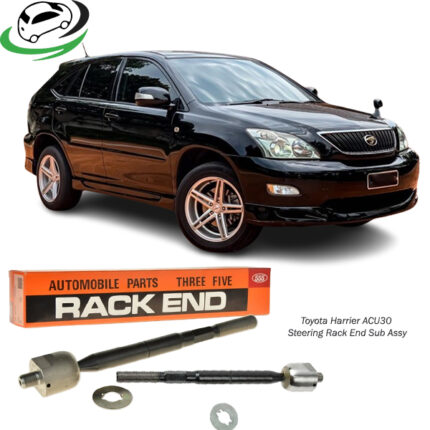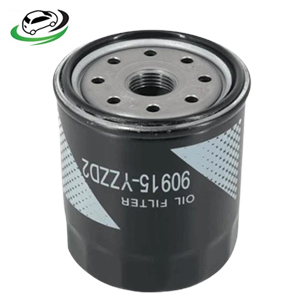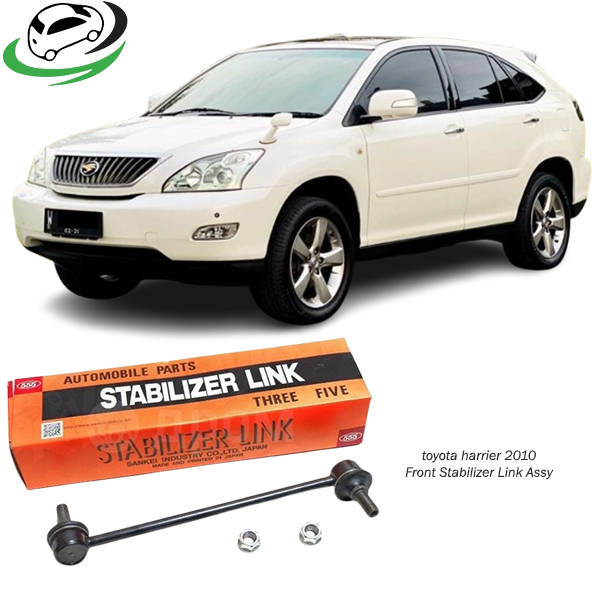-14%
Get Toyota Harrier 2010 Front Stabilizer Link Assy SL3750 in Kenya
The front stabilizer link assembly, also known as a sway bar link or anti-roll bar link, is a critical component of the vehicle’s suspension system. Its main role is to enhance vehicle stability by minimizing body roll during turns, promoting safer handling, and ensuring a smooth ride. Stabilizer links are small but highly influential parts that connect the sway bar (also called the anti-roll bar or stabilizer bar) to the suspension components, such as the control arms or strut assemblies. This article delves into the front stabilizer link assembly’s construction, function, benefits, common issues, and maintenance tips.
1. Construction of the Front Stabilizer Link Assembly
The front stabilizer link assembly is relatively straightforward in design but varies depending on the make and model of the vehicle. Here are its primary components:
- Metal Rod or Bar: The stabilizer link is typically a small rod made from steel or aluminum, known for durability and strength to handle the stresses it endures.
- Ball Joints or Bushings: On each end of the stabilizer link, there are either ball joints or rubber/polyurethane bushings. These connectors allow the link to pivot with suspension movements, facilitating flexibility and minimizing wear.
- Bolts and Fasteners: The stabilizer link is fastened to the sway bar and the suspension control arms or struts using bolts and fasteners. Proper installation of these fasteners is crucial to avoid detachment, which could impact vehicle stability.
Some stabilizer links use non-metallic coatings or protective boots on the ball joints to protect them from dirt, water, and road debris, prolonging the life of the component. The construction of the stabilizer link assembly may vary slightly based on its location in the vehicle, but the design principles remain consistent.
2. Functionality of the Front Stabilizer Link Assembly
The front stabilizer link plays a vital role in connecting the sway bar to the suspension system, which is essential for minimizing body roll.
a. Reducing Body Roll
During a turn, the vehicle’s weight shifts towards the outer wheels, causing body roll. The stabilizer bar, with the help of the stabilizer link, resists this roll by applying an opposing force to the inner wheels. This process is facilitated by the stabilizer link, which transmits the force from the sway bar to the suspension arms.
b. Maintaining Balance and Stability
By distributing forces across the suspension components, the stabilizer link helps maintain the vehicle’s stability, even during sharp turns or on uneven terrain. The link ensures that each side of the suspension works together, balancing the vehicle and allowing it to stay upright.
c. Enhancing Handling and Steering Response
With its connection to the sway bar, the stabilizer link improves handling by providing a responsive and stable suspension system. This enhanced responsiveness aids the driver in maintaining control of the vehicle, especially during sudden steering actions or evasive maneuvers.
3. Benefits of the Front Stabilizer Link Assembly
While a small part of the suspension system, the front stabilizer link assembly offers several benefits that directly impact safety, comfort, and vehicle handling:
a. Improved Cornering and Stability
The stabilizer link plays an integral part in reducing body roll, especially during turns. This benefit improves vehicle stability, helping the car corner smoothly without excessive lean, which is crucial for driver and passenger safety.
b. Enhanced Ride Comfort
The stabilizer link absorbs some of the impact forces that reach the suspension system, smoothing out the ride. By controlling side-to-side movements, it contributes to a more comfortable ride on bumpy or uneven roads.
c. Increased Durability of Suspension Components
Because stabilizer links distribute the forces exerted on the sway bar evenly, they prevent excessive stress on suspension components like struts and control arms. This distribution minimizes wear on these parts, potentially extending their service life.
d. Greater Steering Precision
By reducing unnecessary lateral motion, the stabilizer link improves steering response. Drivers experience more precise and predictable handling, allowing for safer and more controlled driving, particularly on winding roads.
4. Common Issues and Signs of Wear
Stabilizer links are durable but can still wear out due to constant movement, exposure to road conditions, and extreme forces during turning. Here are common issues and signs that may indicate a problem with the stabilizer link:
a. Noise from the Suspension
One of the most common signs of a failing stabilizer link is a clunking or knocking noise when driving over bumps or during turns. This noise often results from worn-out bushings or loose ball joints in the link assembly.
b. Poor Handling and Increased Body Roll
A worn or broken stabilizer link can lead to reduced sway bar efficiency, making the vehicle feel unstable, especially in turns. Drivers may notice increased body roll or an overall “loose” or “wobbly” feeling when steering.
c. Uneven Tire Wear
Since the stabilizer link affects suspension alignment, a damaged link can lead to uneven tire wear. This wear often occurs due to increased side-to-side movements in the suspension, putting excessive stress on the tires.
d. Loosened Linkage
The stabilizer link’s bolts or joints may become loose over time. Loose connections can disrupt the stabilizer link’s function and cause excessive movement or play in the sway bar, impairing vehicle stability.
e. Reduced ABS and Traction Control Efficiency
For vehicles with advanced traction and ABS systems, stabilizer links play a role in maintaining stability data. A damaged stabilizer link may interfere with the system’s ability to keep the vehicle stable, potentially reducing the effectiveness of ABS or traction control.
5. Maintenance Tips for the Front Stabilizer Link Assembly
Proper maintenance of the stabilizer link assembly ensures vehicle stability, reduces wear, and prolongs suspension component life. Here are some maintenance tips:
a. Regular Inspection
Periodic inspections, particularly during tire rotations or suspension checks, are essential. Look for signs of wear on bushings, ball joints, and connecting bolts. These components should be firm and free from excessive play.
b. Replace Worn Components
When the stabilizer link shows signs of wear, replacing it promptly can prevent further damage to the suspension. Unlike some parts, stabilizer links are relatively inexpensive, making timely replacement a practical solution for maintaining performance.
c. Avoid Overloading the Vehicle
Excessive weight or frequent heavy loads can increase stress on the suspension, including the stabilizer links. To reduce strain, adhere to the vehicle’s weight limits and avoid carrying overly heavy loads for extended periods.
d. Drive Cautiously on Rough Terrain
Off-road driving or navigating rough roads frequently can accelerate the wear of stabilizer links. Avoid sudden impacts or harsh driving on such terrain whenever possible to prolong link life.
e. Use High-Quality Parts
Replacement stabilizer links should be of high quality and meet the manufacturer’s specifications. OEM parts or reputable aftermarket options ensure compatibility and durability, promoting consistent performance.
6. Replacement Considerations for Stabilizer Link Assembly
When it’s time to replace the front stabilizer link assembly, there are a few factors to consider for an efficient and successful replacement:
a. Replace Links in Pairs
Even if only one stabilizer link shows signs of wear, it’s often recommended to replace both links on the front suspension at the same time. This ensures even performance and handling, as a new link on one side can create an imbalance with a worn link on the other side.
b. Ensure Proper Torque
When installing new stabilizer links, it’s crucial to tighten the bolts to the manufacturer’s specified torque. Over-tightening can damage the bushings or ball joints, while under-tightening may result in loose connections that can impair performance.
c. Test for Handling and Noise
After replacement, test the vehicle by driving over various road conditions to confirm there are no unusual sounds or handling issues. This test ensures the new stabilizer links are functioning as expected, offering stability and noise-free operation.
d. Consider Professional Installation
While stabilizer links are not complex to install, professional installation is often recommended. A qualified technician ensures correct alignment, proper torque settings, and secure installation, reducing the risk of early wear or malfunction.
Conclusion
The front stabilizer link assembly is a small but essential part of a vehicle’s suspension system, designed to stabilize the car, minimize body roll, and improve handling. By connecting the sway bar to the suspension, it plays a pivotal role in vehicle stability, especially during turns and on uneven roads. Proper maintenance, timely replacement, and attention to signs of wear can ensure the stabilizer link continues to function optimally, contributing to a safer, smoother, and more controlled driving experience.
Follow us on Facebook for more parts.



